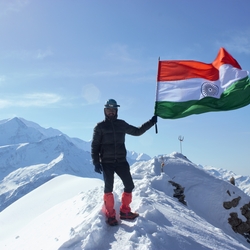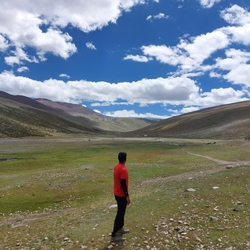Every adventure sport comes with its fair share of risks and with these risks comes the reward. While everyone is aware of the general risks of venturing high up into the mountains, it always helps to know more about the kind of medical emergencies that could possibly arise during a trek and how best to avoid and tackle them. This article details out the information pertaining to such emergencies and provides tips to resolve the same.
Common Injuries, Illnesses, their Prevention and Remedies
Acute Mountain Sickness (AMS)
Above 3000m, the oxygen levels in the air gradually start to decline with the increase in altitude. Our body starts producing more red blood cells as a reaction to lower oxygen levels. AMS occurs when you ascend to a higher altitude in a short period of time without giving your body enough time to adjust to the change. AMS is common on high altitude treks, thus making acclimatisation a safe and important trekking practice. Symptoms of AMS include fatigue, light-headedness, headaches, loss of appetite, shortness of breath, rapid pulse, and nausea. You might notice some of these symptoms at higher altitudes as the body's common response to change in environment. However, when two or more of these symptoms exist together, AMS is suspected and if not treated at the right time, could lead to High Altitude Pulmonary Edema (HAPE) and sometimes High Altitude Cerebral Edema (HACE). HAPE is a result of accumulation of fluid in the lungs. This fluid impairs oxygen exchange and leads to decreased oxygen in the bloodstream, causing impaired cerebral function and even death. HACE results from fluid leakage that causes swelling of the brain tissue.
AMS can be avoided by following a few simple steps and giving your body ample time to acclimatise to the altitude.
- Maintain a slow pace and gain altitude at a gradual rate.
- Hydrate yourself frequently. Drink at least 3-4 litres of water everyday.
- Take ample rest. Ensure that you sleep well and are well rested for the next day.
- Eat nutritious and energy giving food. This will help your body cope with the changes in the atmosphere better.
- Everyone has different rates of acclimatisation. If you are noticing any of the above listed symptoms or generally do not feel good, do not hesitate to inform your trek leader at the earliest.
In case you are affected with AMS, take rest, descend to a lower altitude and do not proceed higher up. Stay warm and consume sufficient food for your body to recover. In severe cases, a person suffering from AMS should be airlifted to the nearest hospital.
Frostbite
In treks and expeditions which usually take you above 3000m, insulating your body becomes extremely important, particularly your palms, face and feet. Lack of or insufficient insulation could lead to frostbite, especially in snow. If you are experiencing a tingling feeling, hard skin, and numbness, it could indicate frostbite.
Frostbite occurs in different stages. The initial stage, also referred to as Frostnip, is mild frostbite that causes skin irritation and changes the skin colour to pinkish-red. This does not cause permanent damage and can be treated with first-aid. The second stage is referred to as Superficial Frostbite and results in the formation of fluid-filled blisters 12-36 hours after rewarming your skin. Deep Frostbite is the advanced stage where your skin starts turning black and hard as the tissue underneath slowly dies. You will notice large blisters 24-48 hours after rewarming, accompanied by numbness and joint/muscle impairment.
Following are a few tips to avoid frostbite:
- Wear extra layers of gloves and socks. This will provide additional insulation and keep your palms and feet warm even at higher altitudes.
- Do not walk around barefoot at campsites or dip your hands and feet in icy lakes and rivers at high altitudes. This will make you more prone to frostbite.
- Wear climbing boots and clothing that are of the right size and fit. Tight boots and clothing will restrict your blood flow. Similarly, oversized boots and clothing will not keep you warm enough.
In case you are affected with frostbite, rewarm the affected part with skin-to-skin contact. Wear more layers and keep yourself warm. For a deeper frostbite, submerge the affected part in water that is a little above body temperature. Wait until the numbness fades and bandage the area with a gauge. Do not warm the numb affected area with the help of a heat source like fire; you could end up burning yourself when you cannot feel your skin.
Blisters
These are one of the most common injuries on treks. Blisters develop on long treks with the movement of boots and socks along the skin on the feet. The outer layer of our skin moves more than the soft layers on the inside, thus creating a gap and resulting in the formation of pus due to the friction. Blisters can be painful and also extremely inconvenient to trek with. Following are a few tips to prevent blisters and make sure you have a fun filled trek.
- Always wear boots that fit your feet properly and do not leave too much room for movement.
- If you are buying new trekking boots, make sure you use them prior to the trek by walking short distances until they soften a little.
- Trim your toenails and keep them blunt. This will ensure that there is no pressure on your toes when you wear the boots.
- Ensure that you are wearing socks that are fully dry and ones that do not hold in moisture.
- Clean your feet before wearing socks. Dirt on your feet can amplify the friction.
In case your feet have been affected with blisters, clean it with a disinfectant. For blisters that are big and are a hindrance while walking, gently pop the blister using a clean needle. Disinfect the needle with alcohol wipes and drain out the pus. Cover the area after applying a disinfecting ointment.
Ankle Twists and Sprains
Ankle twists and sprains are common on all treks. You might be strolling through the meadows of Tosa Maidan and it is highly possible that you step on a stone and twist your ankle or sprain your knee. While most ankle twists are minor and resolve on their own within a few minutes, an ankle twist or sprain accompanied with severe pain could be difficult to treat while on a trek. It requires a certified first-aid provider to help with the same. Following are a few basic tips to avoid ankle and knee injuries on a trek.
- Wear ankle length trekking boots which offer extra support and minimise ankle twists and sprains. They also provide you with a better grip while walking and avoid knee injuries.
- Look where you step. While we understand that it is hard to look down when everything up above is so stunning, a quick check on the ground could help you have a pain free trek.
In case of an ankle twist or sprain, rest your foot until the pain has subsided. In severe cases, you will notice a swelling. Give your foot complete rest, apply a cold compress and elevate your foot. You can use a crepe bandage to compress the affected area.
While these are the most common and major injuries you might encounter on a trek, small cuts and scrapes, nausea, fever and flu are also possible. These can be treated with common medicines, wound dressing and resting your body as much as possible. Whether minor or severe, always inform the trek leader of your wellbeing and any concerns you might have. This will allow them to take timely action and ensure your safety.
Things to Carry in a First Aid Kit on a Trek
Following are a few things to keep handy in your first aid kit:
- Your first aid kit should contain general medicines such as paracetamol, diamox, antacid, avomine (Check table below) and any specific antibiotics based on a doctor’s prescription. Also carry the medicines you have been prescribed for any conditions that you are already susceptible to.
- Wound dressing and disinfectant
- Cotton and gauge
- Crepe bandage
- Splint for fractures and twists
- Sterilised needle and tweezers
Following is a table indicating medicines and the symptoms they relieve:

Our trek leaders are well equipped to provide basic medical care and will also be carrying necessary medicines and first aid. They are gender sensitised and trained in basic medicine and first-aid response. Rest assured, you will be in good hands should an emergency arise.
Emergency, Safety and Rescue Protocol at Bikat
In addition to their qualifications, our trek leaders are trained to tackle any and all kinds of sudden conditions that may present themselves on ground. During our recce stage, we study the trail in great detail and map out rescue routes before opening it up for our trekkers. We also have local support staff stationed in each area to arrange for emergency services at the place of need as quickly as possible.
While there are precautions you can take to prevent any serious injuries or health conditions, we understand that it is the nature of mountains to be unpredictable and we like to be prepared for immediate action.
We mobilise road rescue efforts where our trek leaders bring the person to be rescued down to the trailhead of the trek from where a car can take them to the nearest healthcare facility. The cost of rescue is not covered in the trek fee that we charge. It must be borne by the participant. However, if you opt for the insurance (highly recommended for any adventure/outdoor activity), the cost of rescue operations can be claimed from the Insurance company on production of valid proof e.g. doctor’s prescription & hospital bills etc. Although not mandatory, we recommend buying the insurance to cover for the cost of rescue, evacuation and any other emergency service required as well as to cover for medical costs in case of injury or illness during the trek.
In case of an emergency, inform the trek leader. The trek leader will make radio contact and arrange for necessary action and support. In the meantime, depending on the nature of the injury, trek leaders will provide basic medical care.
- In case of a non breathing patient, provide CPR and rescue breaths until help arrives or the patient starts breathing on their own.
- For AMS, provide the patient with 100% O2 and ensure they stay hydrated.
- For hypothermia and frostbite, wrap the patient in a blanket and ensure they stay warm.
- In case of fractures, splint the fracture to avoid further movement.
The above information covers all the basic steps to follow in case of illnesses and injuries while on a trek. While all our team members are equipped to provide the care needed, it always helps if you are also aware and familiar with providing first aid when needed. Should you have any further queries on the above information, do not hesitate to reach out to us.






